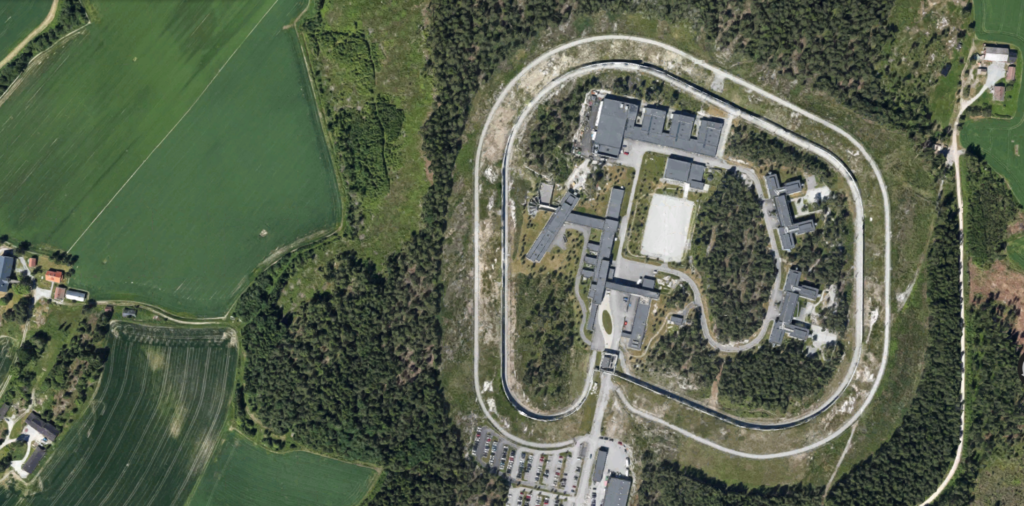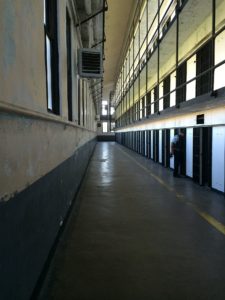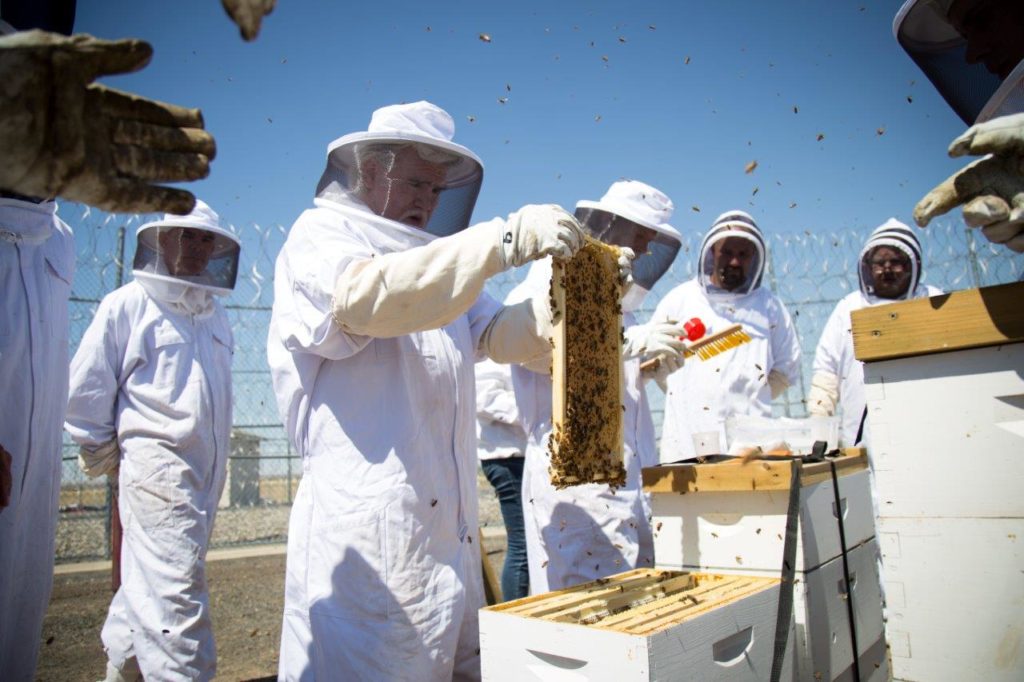
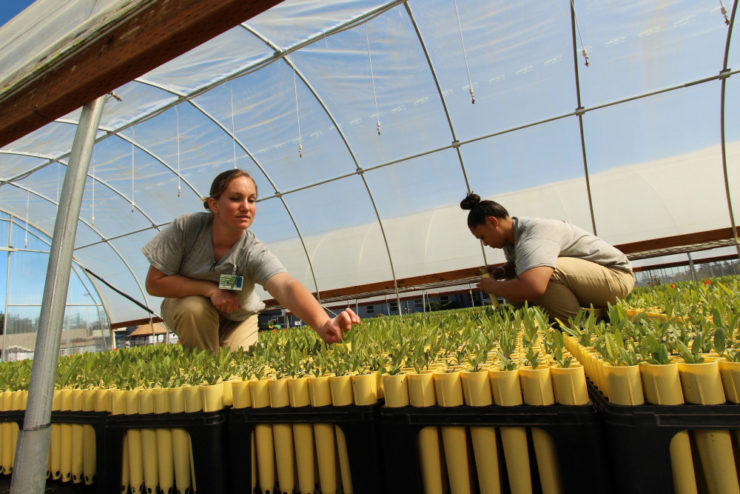
Features
Prison, Nature and Social Structure
Terrapin Bright Green
Share
Learn more about our biophilic design work and services by emailing us at [email protected] and reading our reports, 14 Patterns of Biophilic Design and The Economics of Biophilia. Follow the conversation on twitter: @TerrapinBG | #14Patterns.
By Lilli Fisher
What’s the purpose of a prison? Answering this question might seem straightforward, but the answer varies depending on who you ask. The complexity of the issue is revealed by the diverse incarceration systems that exist around the world. In the United States, most prisons are austere environments, designed to restrict movement and facilitate surveillance.1 In many Scandinavian countries, prison systems operate on the opposite end of the spectrum, valuing rehabilitation over punishment and security. In Norway, for example, attractive buildings in campus style layouts are designed to mimic life outside the prison in order to ease the transition back into society.2 A society’s collective thoughts, feelings, and beliefs about crime are manifested in the physical spaces constructed to contain individuals who break the law.
Halden: A Prison in the Woods
Norwegian penal philosophy focuses on rehabilitating inmates through humane treatment and a “guiding principle of normality,” the idea that life inside the prison should feel as much like regular life as possible.2 Halden Prison, a high-security facility designed by HLM Arkitektur in collaboration with Erik Møller Arkitekter,3 exemplifies the Norwegian Ministry of Justice’s policy of reintegration. Halden is a collection of buildings contained inside a tall curving wall and surrounded by a forest of spruce, scotch pine, and blueberry bushes. Inmates are allowed to roam the wooded grounds unaccompanied by guards, buy groceries from the prison grocery store, and cook their own meals. Correctional officers socialize with inmates regularly over tea, lunch, or board games—part of what the Norwegian Correctional Service refers to as dynamic security, a philosophy that views maintaining prison safety as dependent on the interpersonal relationships developed between inmates and staff.4
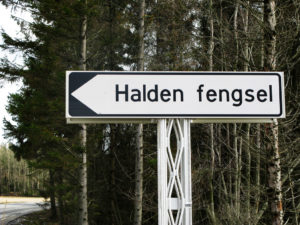
The sign on the forest highway to Halden Prison. Courtesy of Justis- og beredskapsdepartementet via Flickr.
Halden’s two-story buildings—constructed in fired brick, untreated wood, and galvanized steel—retain a human scale, and the furniture inside the clustered living areas resembles a college dorm room more than a prison.4 Biophilic design features, such as variation in spatial conditions, natural light infiltration, materials and patterns that evoke the natural world, views of the outdoors through the windows, and opportunities for direct contact with nature, are present throughout the campus. These biophilic qualities promote psychological health among the inmates and the staff by reducing stress, improving cognitive functioning, and enhancing mood. To many Americans, these design features may seem like luxuries. Most Americans believe that prisons are supposed to be unpleasant: they are, after all, a form of punishment. But is punishment really the best end goal?
Static Security
Just as Norway’s prisons are designed based on Norwegian penal philosophy, American prisons are designed based on the United States’ prevailing attitudes toward crime. American prison design is a manifestation of the static security strategy, which focuses on reducing opportunities for criminal behavior by restricting access to different areas within the prison, using materials that are designed for security purposes, such as tamperproof screws and toughened glass, and installing around-the-clock video surveillance.1 Static security controls limit the need for direct interaction between inmates and correctional officers in order to reduce confrontation, but as a result, they may also inhibit relationship building and the development of a sense of community.1 Static security measures assume that, if provided the opportunity, the inmate will engage in negative behavior. Dynamic security measures like those at Halden, on the other hand, provide a social structure in which the incentives to engage in negative behavior are removed and assume that the inmate will adapt their behavior. This rehabilitative strategy prepares inmates to make positive choices when they are released.
You may find yourself wondering, “Why do US prisons focus on static security rather than dynamic security?” To begin to answer this, we have to trace US policy back to a 1975 report commissioned by the New York State governor. Rehabilitation was deemphasized in the United States after the popularization of the report known simply as the Martinson Report. The work surveyed 231 studies of offender rehabilitation dating from 1945 to 1967 and found that, in Martinson’s words, “Nothing works!”5 Despite the fact that numerous studies contradicted the results, even Martinson refuted his famous words in a later publication, the Martinson Report has had a lasting effect on US penal policy.5 Unfortunately, ideas popularized in the Martinson report are reflected in the static security measures used in US prison design today. Small windows, tight spaces, bright artificial lights, hard tamperproof furniture, and spatial layouts that limit privacy and freedom of movement are all products of ill-informed prison policy. While these design choices are intended to improve behavior they create conditions that may exacerbate psychological issues and contribute to negative inmate behavior.
Small windows, tight spaces, bright artificial lights, hard tamperproof furniture, and spatial layouts that limit privacy and freedom of movement are all products of ill-informed prison policy.”
A 2006 report from the US Bureau of Justice Statistics found that over half of all US inmates, 45% of federal prisoners, 56% of state prisoners, and 64% of local jail inmates, had symptoms consistent with a mental health disorder. In comparison, just 11% of the US general population has the same symptoms.6 High rates of mental illness make the inmate population especially vulnerable to the environmental stressors of US prison design. A study funded by The National Institute of Justice found widespread psychological health issues among correctional officers as well, with 25% reporting a lack of emotional responsiveness, approximately 13% reporting a feeling of hopelessness and/or worthlessness, and 6% reporting having thoughts of suicide 1-2 times in the past six months.7 Biophilic interventions in prison architecture could help to ease the work-related stress experienced by correctional officers and promote psychological health in the inmate population. These interventions would create a more comfortable environment and provide opportunities for restorative moments throughout the day.
Biophilic Design in Prisons in the US?
Norway and the United States have radically different views on incarceration, but we are also operating within radically different contexts. The total population of incarcerated individuals in Norway is approximately 3,700 compared to the United States’ 2.2 million, a population greater than the city of Philadelphia, the 5th largest city in the US.8,9 While the US spends on average $31,000 per inmate per year, Norway spends upwards of $93,000 per inmate per year on Halden’s occupants.4 Norway’s lower incarceration rate, 70 prisoners per 100,000 people compared to the US’s 693, allows for a significantly larger budget per inmate.8,9 For reasons that are philosophical, political, economic, and logistical, the US isn’t going to be building Halden-esque prisons any time soon. Rehabilitative programming that enters existing prison structures, however, can provide many of the same benefits without requiring a major shift in existing prison structure.
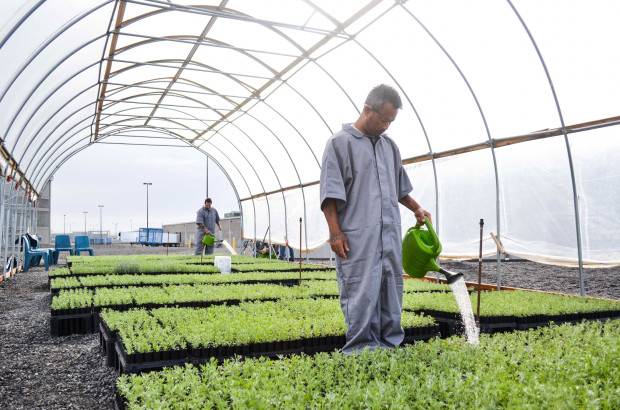
Water sagebrush in conservation nursery at Coyote Ridge Corrections Center. Courtesy of Megan Murry.
“Green” Rehabilitation for Prisons
Since the 1990s, “green” rehabilitation programs have been slowly gaining popularity in the US. In these programs, inmates engage with nature through activities such as gardening, animal care, and ecological monitoring. Several successful green rehabilitation programs exist including Washington State’s Sustainability in Prisons Project, San Francisco’s Garden Project, Ohio’s Sandusky County Jail Gardening program, California State’s Insight Garden Program in San Quentin, and New York City’s GreenHouse program on Rikers Island.10 While these programs do not change the design of prison buildings, they do provide small-scale biophilic interventions, such as garden spaces within previously bare concrete exercise yards. Furthermore, these programs shift the social structure within prisons by reducing stress and mental anguish and by encouraging teamwork.
The Sustainability in Prisons Project (SPP), created in 2003, is a prime example of a program successfully using these types of interventions in the US. A collaborative project between Evergreen State College and the Washington State Department of Corrections, SPP has four areas of focus: “science and sustainability education, conservation, sustainable operations, and community contributions.” Inmates at any of the 12 prisons involved in the program engage with nature in activities such as gardening on prison grounds, participating in low-tech composting, learning how to keep bees, harvesting honey and making value-added products from beeswax, nurturing abused dogs, and contributing to scientific research.11
The SSP cultivates a sense of hope among the inmates, reduces the stress associated with prison environments, improves work ethic, and develops green-collar job skills. One inmate who learned to care for and train abused dogs in the program said, “seeing them get a second chance, and being part of that second chance gives me greater hope for my future as well as theirs.”11 The opportunity to participate in a productive interaction with nature allows the inmate to see herself/himself in a different role and imagine a different future. The social and environmental benefits of the SSP do not come at an economic cost. The program has actually resulted in cost avoidance of an estimated $4.3 million annually through sustainable building operations and a “more positive and productive prison culture.”12
Green rehabilitation programs have also been shown to reduce inmates’ likeness to engage in criminal behavior after release. A study by Sander van der Linden of the Princeton University Department of Psychology, compared reconviction rates of inmate participants from the Rikers Island GreenHouse and GreenTeam programs to New York State and national reconviction rates. Three years after release, 42% of inmates released in the State of New York and 45.2% of inmates released nationwide had been reconvicted. By comparison, the GreenHouse and GreenTeam programs had a reconviction rate of just 31%, a significant reduction from the national and state rates. The GreenHouse and GreenTeam programs’ success is even more impressive when compared to the 65% long-term reconviction rate of the general inmate population at Rikers Island.11
A Better Prison System
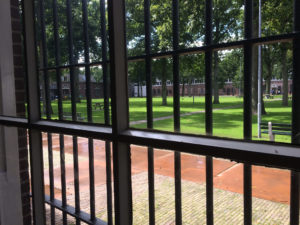
Visual access to nature through prison bars. Courtesy of Justis- og beredskapsdepartementet via Flickr.
Many of the inmates confined in the US struggled with economic, social, or psychological burdens prior to incarceration. The prison system places these individuals in an environment that increases stress, aggravates psychological issues, strains positive interpersonal relationships, builds negative social networks and creates additional barriers to securing employment upon release. The opportunities for interaction with nature that green rehabilitation programs offer could improve health and wellbeing for inmates by reducing stress. These programs employ biophilia to cultivate positive self-identity and develop job skills, easing the inmate’s transition back into society. In addition, green rehabilitation programs foster a pro-social culture and provide small-scale biophilic interventions on-site, which could help to reduce the work-related stress that afflicts so many correctional officers today.
The American ideals of justice and security do not have to come at the cost of successful reintegration.”
Green rehabilitation programs can provide these social benefits within the current US prison system without incurring high costs; some even save money. The American ideals of justice and security do not have to come at the cost of successful reintegration. While the prison system may always be a polarizing topic in the US, I believe that most Americans share the goal of improving the health of all citizens and reducing crime and incarceration rates. Biophilic interventions in prison programming may be an economically feasible solution that could improve the health of inmates and correctional officers alike while reducing the likeliness of reoffending upon release.
*Header Image: Watering prairie plants in conservation nursery at WA Corrections Center for Women. Courtesy of Joslyn Rose Trivett. Sustainability in Prisons Project.
 Lilli Fisher is currently pursuing a master of science in Sustainable Environmental Systems at Pratt Institute and has recently completed a fellowship with Storm Water Infrastructure Matters (S.W.I.M) Coalition, in which she mobilized citizens around NYC’s pressing water quality issues. In her work, Lilli explores the interconnection of ecology and human health in the urban environment. At Terrapin Lilli is working with the Biophilic Design team to produce new case studies that reveal how biophilic design principals have been implemented in a variety projects worldwide. Linkedin.
Lilli Fisher is currently pursuing a master of science in Sustainable Environmental Systems at Pratt Institute and has recently completed a fellowship with Storm Water Infrastructure Matters (S.W.I.M) Coalition, in which she mobilized citizens around NYC’s pressing water quality issues. In her work, Lilli explores the interconnection of ecology and human health in the urban environment. At Terrapin Lilli is working with the Biophilic Design team to produce new case studies that reveal how biophilic design principals have been implemented in a variety projects worldwide. Linkedin.
References:
-
Lulham, Rohan, Douglas Tomkin, Luke Grant, and Yvonne Jewkes. “The Risk of ‘A Cold Conservatism in Correctional Facility Design: The Case for Design Innovation.” Advancing Corrections Journal: Edition# 1-2016 (2016): 12-13.
-
Deady, Carolyn W. “Incarceration and recidivism: Lessons from abroad.” Pell Center for International Relations and Public Policy. 2014: 3.
-
Vinnitskaya, Irene. “Halden Prison / Erik Møller Arkitekter + HLM arkitektur- The Most Humane Prison in the World” Architecture Daily 29 July 2011. Web. 22 June 2016.
-
Benko, Jessica. “The Radical Humaneness of Norway’s Halden Prison.” New York Times 26 March 2015 Web. 22 June 2016.
-
Miller, Jerome G. “The Debate on Rehabilitating Criminals: Is It True that Nothing Works?” The Washington Post March 1989. Web. 22 June 2016.
-
James, Doris J., and Lauren E. Glaze. “Highlights: Mental Health Problems of Prison and Jail Inmates.” Washington, DC: Bureau of Justice Statistics (2006): 1.
-
Rogers, John B., Connecticut Dept of Correction, and the United States of America. “FOCUS I Survey and Final Report: A Summary of the Findings: Families Officers and Corrections Understanding Stress.” (2001): (2001) 59.
-
“World Prison Brief: Norway” Institute for Criminal Policy Research. 1 January 2016. Web. 28 June 2016.
-
“World Prison Brief: The United States” Institute for Criminal Policy Research. 30 June 2014, 31 December 2014. Web. 28 June 2016.
-
van der Linden, Sander. “Green prison programmes, recidivism and mental health: A primer.” Criminal Behaviour and Mental Health 25, no. 5 (2015): 338-339.
-
White, Rob, and Hannah Graham. “Greening justice: examining the interfaces of criminal, social and ecological justice.” British Journal of Criminology 55, no. 5 (2015): 854.
-
“The Evergreen State College and Washington State Department of Correction’s Sustainability in Prisons Project.” Sustainability in Prisons Project. 2016. Web. 27 June 2016.
Topics
- Environmental Values
- Speaking
- LEED
- Terrapin Team
- Phoebe
- Community Development
- Greenbuild
- Technology
- Biophilic Design Interactive
- Catie Ryan
- Spanish
- Hebrew
- French
- Portuguese
- Publications
- Occupant Comfort
- Materials Science
- Conference
- Psychoacoustics
- Education
- Workshop
- Mass Timber
- Transit
- Carbon Strategy
- connection with natural materials
- interior design
- inspirational hero
- biophilia
- economics of biophilia
- Sustainability
- wood
- case studies
- Systems Integration
- Biophilic Design
- Commercial
- Net Zero
- Resorts & Hospitality
- Energy Utilization
- Water Management
- Corporations and Institutions
- Institutional
- Ecosystem Science
- Green Guidelines
- Profitability
- Climate Resiliency
- Health & Wellbeing
- Indoor Environmental Quality
- Building Performance
- Bioinspired Innovation
- Biodiversity
- Residential
- Master Planning
- Architects and Designers
- Developers and Building Owners
- Governments and NGOs
- Urban Design
- Product Development
- Original Research
- Manufacturing
- Industrial Ecology
- Resource Management
- Sustainability Plans
- Health Care
- Carbon Neutrality

